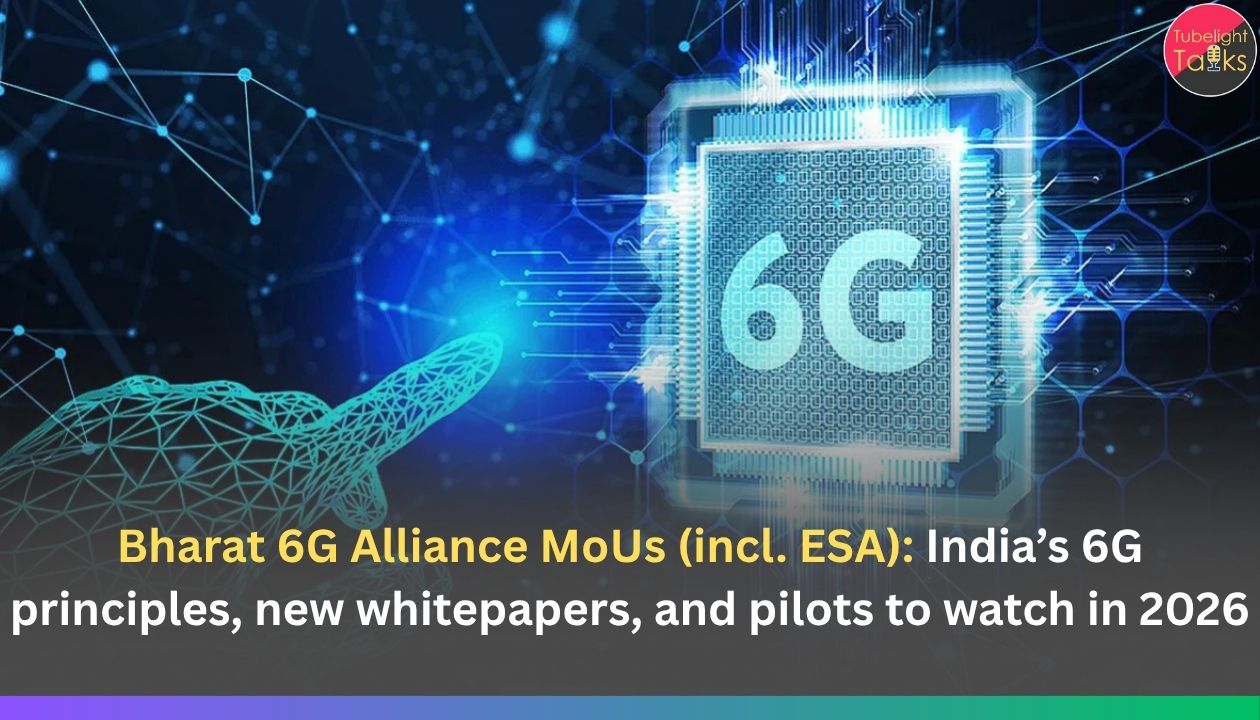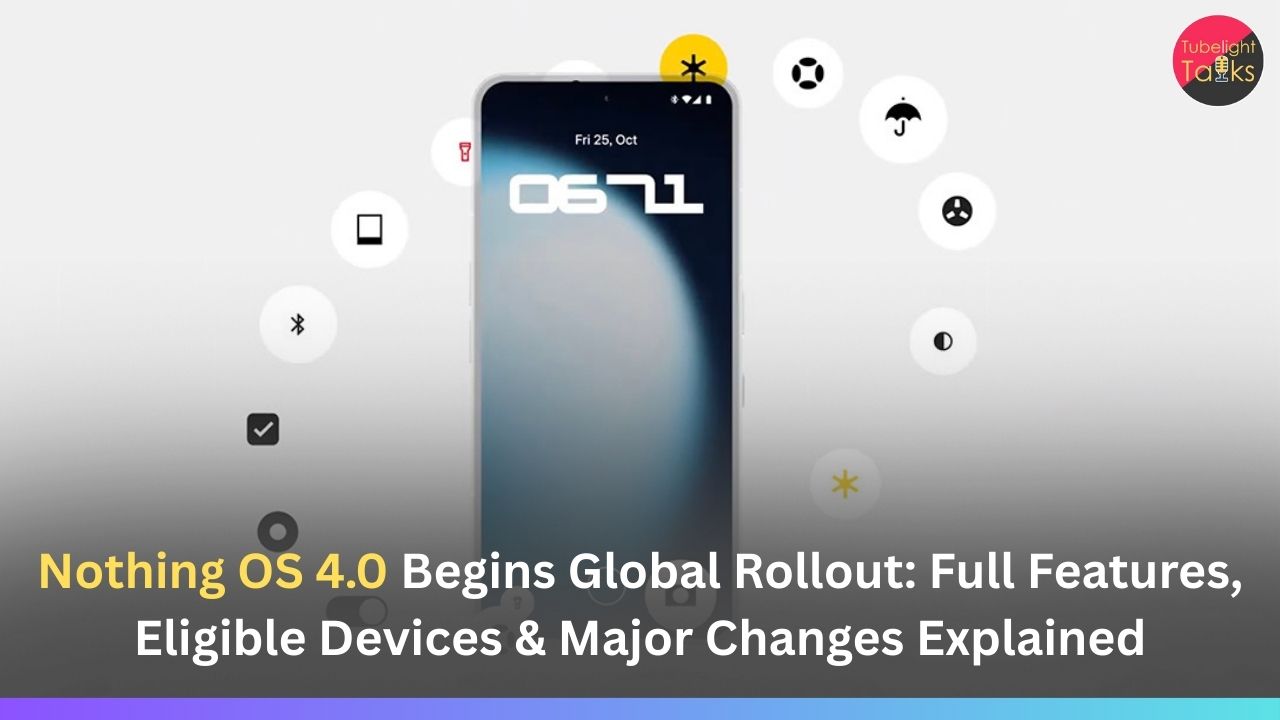Bharat 6G Alliance MoUs: India’s Bharat 6G Alliance (B6GA) used the International Bharat6G Symposium (Oct 9–10, 2025) to lock in fresh international partnerships and publish whitepapers that sketch the path from R&D to pilots. The Ministry/PIB notes MoUs with European Space Agency (ESA) and NASSCOM, alongside earlier tie-ups with ATIS’ Next G Alliance (US), 6G-IA (EU), 6G Flagship (University of Oulu, Finland), 6G Forum (Korea) and others—creating a channel for joint research, standards and cross-border trials.
The ESA piece
ESA confirms a Memorandum of Intent with B6GA to co-develop satellite-enabled 6G—i.e., integrating non-terrestrial networks (NTN) with terrestrial 6G for seamless, resilient coverage. Expect this axis to shape field pilots where space and ground networks co-work.
The principles: Delhi Declaration on “6G by Design”
At the symposium, leading 6G alliances (B6GA, 6G-IA, Next G Alliance, 6G Forum, 6G Flagship, 6G Brazil, UK networks and others) issued a joint Delhi Declaration: 6G must be Trusted & Secure, Resilient & Reliable, Open & Interoperable, Inclusive & Affordable, and Sustainable & Globally Connected. That framing now underpins India’s collaborations and pilot criteria.
The documents: new whitepapers you should read
B6GA’s site lists the latest releases (Oct 2025 set in bold):
- Spectrum Roadmap for 6G in India (B6GA Spectrum WG) — priorities through IMT-2030 and WRC cycles.
- Powering the Next-Gen Telecom (Oct 2025) — energy efficiency for macro & small-cell 6G.
- AI and Network Evolution to 5G Advanced & 6G — AI-native architecture direction.
- 6G Data Architecture, Security & Exposure Framework for RF Sensing — secure sensing-comms fusion.
- The Potential of OTFDM Waveform & Structural-MIMO — candidate PHY techniques.
Pilots to watch in 2026 (evidence-based picks)
- NTN + terrestrial integration (satellite-enabled 6G): With the B6GA–ESA collaboration formalised, expect proof-of-concepts that stitch LEO/GEO links into backhaul or direct-to-device 6G stacks in India.
- THz communications testbed trials: DoT has funded a national 6G THz Testbed (SAMEER + IITs). Moving from lab to limited pilots is the natural 2026 step.
- Advanced Optical Communication testbed: Government-backed optical testbed (IITs + industry) sets up high-capacity fronthaul/backhaul pilots.
- AI-native RAN/control-plane trials: Aligned with B6GA’s AI→6G paper—closed-loop optimisation, energy-aware schedulers and intent APIs at campus/city scale.
- RF sensing & exposure framework: Early demos operationalising the security/exposure guidance for sensing-as-a-service.
- Energy-efficient macro/small-cell sites: Field comparisons using techniques from the Powering Next-Gen Telecom paper.
Who’s at the table (quick roll-call)
- International MoUs/MoIs: ESA, 6G-IA, Next G Alliance, 6G Flagship (Oulu), 6G Forum (Korea), 5G-ACIA, XGMF (Japan), NGMN, 6G Brazil, UK networks; domestic MoUs with TSDSI and NASSCOM.
Where India stands now (R&D spine)
- Testbeds & labs: Two national 6G testbeds (THz, Advanced Optical), 100 5G labs for academia/startups, and 100+ approved 6G research proposals under DoT funds.
- Vision pillars: Ubiquitous coverage, affordability, sustainability—carried into the Spectrum Roadmap and alliance messaging.
What it means for operators & startups
- Operators get a standards-aligned runway: principles + MoUs = less risk of “orphan specs.”
- Startups can target NTN integration, AI-RAN tooling, sensing services, energy-saving site gear—all mapped to B6GA documents and testbeds.
A values lens that fits the moment
Progress is more than speeds and specs. Sant Rampal Ji Maharaj spiritual teachings emphasise truthfulness, non-harm, service, and restraint—a practical checklist here: publish transparent trial results, design for energy frugality, ensure privacy-by-design, and keep rural users first in line for ubiquitous coverage.
The Road Ahead: From MoUs to Measurable 6G Gains
If 2025 was about alliances and papers, 2026 must be about working demos and hard metrics. The ESA tie-up should yield NTN–terrestrial pilots while India’s THz and advanced-optical testbeds move from lab logs to city-scale trials, and AI-native RAN proves real energy and latency savings. Keep score with public KPIs coverage in rural zones, Joules-per-bit, open-interface compliance, and Indian IP filed so progress is auditable, not aspirational.
Do that, and by 2027–28 India won’t just be a participant in 6G; it will be setting specs, exporting solutions, and closing the digital gap with technology that’s secure, interoperable, affordable and sustainable.
Also Read: IISF 2025 Announced for Chandigarh (Dec 6–9): Theme, Tracks, Who Should Attend, and How to Join
FAQs: Bharat 6G Alliance MoUs & 2026 pilots
1) What is the Bharat 6G Alliance (B6GA)?
A government–industry–academia forum shaping India’s 6G R&D, standards, and pilots—so Indian use-cases and IP feed into IMT-2030 and beyond.
2) Which new MoUs matter most?
Tie-ups with the European Space Agency (ESA) plus 6G-IA (EU), Next G Alliance (US), 6G Flagship (Finland) and 6G Forum (Korea)—opening doors for joint research, standards work, and cross-border trials.
3) What do the latest whitepapers cover?
Spectrum roadmap; AI-native networks; energy efficiency for sites; RF sensing security/exposure; and candidate waveforms (e.g., OTFDM, Structural-MIMO).
4) Which pilots should we watch in 2026?
Satellite-enabled (NTN) 6G demos with ESA partners, THz and advanced optical testbed trials, and AI-RAN closed-loop optimization at campus/city scale.
5) How can operators/startups use this now?
Align R&D with B6GA papers, propose trials on NTN/AI-RAN/energy-saving site tech, and plug into national testbeds—so solutions are standards-ready and eligible for co-funded pilots.










